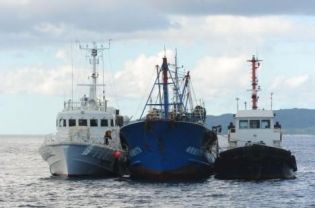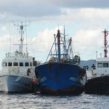
New Twists over Old Disputes in China-Japan Relations
By:

Sino-Japanese relations took a decisive turn for the worse in the past month. At issue, Japan’s seizure of a Chinese trawler and its crew, and then the continuous detention of the captain after the crew and the boat were released. Tokyo accused the Chinese fishermen of illegally entering Japanese territorial waters and causing damage to two Japanese coast guard ships in the subsequent confrontation and chase. Tokyo declared that the captain would be tried according to Japanese laws. Beijing angrily denounced such actions and demanded the skipper’s immediate and unconditional release. When Japan refused, China took a range of retaliatory measures that forced Tokyo to capitulate and release the captain to go home without charge. Although there were signs of improvement when Chinese premier Wen Jiabao and Japanese prime minister Naoto Kan met briefly at the recently concluded Euro-Asia Summit, the damage to bilateral ties is severe, the reconciliation process will be complicated and the strategic implications are profound.
Troubled Waters in East China Sea
The territorial disputes between the world’s second and third largest economies are not new. Japan asserts that Senkaku islands have been part of its territory since 1895 while China insists that these islets, called Daoyu or Daoyutai in Mandarin, have been part of Chinese territory since ancient times but only occupied by the Japanese through force after Japan defeated the Qing Dynasty in the 1894-95 Sino-Japanese War. Taiwan also claims these islands as its territory. All sides have produced their own evidence to support their respective sovereignty claims.
While neither China nor Taiwan have challenged Japan’s de facto administrative control of the Daoyu/Senkaku area over the years, there have been regular skirmishes between Chinese and Taiwanese fishermen and Japanese coast guard ships. There were also occasions that protest boats organized by Chinese activists from Hong Kong, Taiwan and the mainland tried to land on these islets, causing media attention and shining the spotlight on the ongoing disputes.
Both the Chinese and Japanese governments, however, had handled such situations with relative restraint. Neither side had made any dramatic moves to impose their own version of ultimate control other than some symbolic measures from time to time. In almost all major bilateral diplomatic events, such as during the negotiations for establishing diplomatic relations in the early 1970s, the Japanese emperor’s visit to China in 1992 and other key summit meetings, both sides agreed to shelf the sovereignty issue rather than "settle" it.
Following the enactment of the United Nations Convention on the Law of the Sea (UNCLOS) in 1994, which calls for establishing joint resource management, Japan and China signed a fisheries agreement in 1997 (which took effect in 2000) to coordinate fishery activities in the East China Sea. With the increasing need for energy in both Japan and China in recent years, both sides have been talking about joint exploration and development of potential oil and gas fields in the disputed waters around Senkaku/Daoyu islands.
Thus, the implicit arrangement for the status quo around the troubled waters of the East China Sea is that China, Japan and Taiwan claim sovereignty over Daoyu/Senkaku; Japan exercises administrative control over the area; when incidents occur involving Chinese or Taiwanese fishing boats, or protesters, the Japanese coast guards drive them away; after some exchanges of sovereignty rhetoric from each side following such clashes, things go back to the way they were. At the same time, after many rounds of negotiations, Beijing and Tokyo are not even close to reaching an agreement on joint exploration of the natural resources in the region. Yet, China has not gone ahead with production of the gas fields it has been working on near the disputed area, nor has Japan pursued its own drilling activities in nearby waters.
Tokyo’s Miscalculations and Beijing’s Escalated Reactions
Beijing perceived the arrest of the Chinese fishing crew on September 7 and later the prolonged detention of the captain by Japan as a unilateral break from the status quo, an escalation of Tokyo’s assertion of sovereignty other than de facto control of the Senkaku/Daoyu area, and an open call of China’s bluff by Japan when Tokyo planned to try the skipper according to Japanese domestic law.
The Chinese leadership, however, appeared to have chosen a more measured approach in the beginning, mainly through diplomatic channels. The Chinese Ministry of Foreign Affairs issued a series of strongly worded demands for the crew’s release. Within a span of six days, the Chinese side had summoned the Japanese ambassador in Beijing, Uchiro Niwa, five times, including a summon at 2:00 am on September 12 by China’s state councilor, Dai Bingguo (Kyodo News, September 25). Beijing also called off planned East China Sea gas field negotiations. Even after Japan released the trawler and its crew on September 13 but continued to detain the captain for another 10 days, the Chinese authorities were cautious. In leading up to the 79th anniversary of Japan’s invasion of the Northeast part of China on September 18th, the government discouraged public protests against Japan through its controlled media. The outburst of anti-Japanese demonstrations on the sensitive day was only scattered around a few Chinese cities.
It may well be that Beijing expected that a well-controlled September 18 anniversary would lead to Japan’s release of the skipper. Yet that did not happen. Instead, the next day the local Japanese court announced that the Chinese captain would be detained for an additional 10 days.
This decision marked a turning point in the Chinese approach on how to respond to Japan’s actions in the incident. The Chinese side immediately announced that it would take retaliatory measures against Japan in wide-ranging areas. On September 23, some Japanese companies discovered that their imports of rare earth from China were stopped by the Chinese customs, even the Chinese Ministry of Commerce denied issuing an official ban. China currently produces 97 percent of the world’s rare earth and half of its import goes to Japan for processing to be used in high-tech products such as superconductors and highbred cars. The report of Chinese action sent shock waves around Japan and the world. And on the same day, four Japanese company employees working in China were arrested on the pretense of entering forbidden military zones.
When the local Japanese court released the Chinese captain on September 25, it cited consideration for the overall health of Japan’s relations with China. It was clear that Tokyo could no longer bear the mounting pressure from Beijing and caved in (the pressure asserted on the local judicial offices from the Prime Minister’s office was reported by Kyodo on September 26).
The interesting question is what led Prime Minister Kan’s administration to handle the situation as it did? First, it is puzzling why the Japanese coast guards broke with normal practice (e.g. chasing the fishing boat away, and arrested the crew in the first place). If it was due to the damage the Japanese ships received in the collision, then Japan had two other occasions when it could have let the captain return home while still making a point of imposing sanctions against the Chinese crew. One was to release the captain with the rest of the crew, and the other was to free him on September 18, citing Chinese government’s moderate behavior for not fanning anti-Japanese feelings. The Japanese government could have reiterated its sovereignty claim yet pronounce that for the overall well-being of the broader "strategic and mutually beneficial relationship with China," release the captain. It missed these opportunities and proceeded apparently without a plan on how to respond to potential Chinese escalations.
Implications for Sino-Japanese relations and regional security
It would be mistaken to conclude that China has come out of this confrontation the ultimate winner. Yes, the Japanese government appeared to be humiliated when it had to succumb to Chinese pressure. It is also true that the new cabinet of PM Kan paid a heavy price for such mismanagement, with the latest opinion polls showing his support rate at 47.6 percent, a 17 percent drop over one month ago (Kyodo News Survey results, October 6). Yet, China’s heavy-handed measures, ranging from suspension of bilateral talks in areas unrelated to the crisis to stopping a number of local-level and people-to-people exchanges that were planned long before the incident, have left a very negative image in Japan.
Opposition parties in the parliament, while criticizing the Kan cabinet for its incompetence, also rallied to condemn China. Even the Japanese Communist Party demanded that the government must deal with Beijing more "resolutely" on territorial issues. In the public sphere, 72 percent of the Japanese thought the decision to release the Chinese captain was inappropriate, and 90 percent thought China was not justified to ban the exports of rare earth as retaliation against Japan. With Japans’ trade relations with China occupying 20 percent of Japan’s total trade volume (in contrast to the share of 13 percent by the United States), there is growing concern of overdependence on the Chinese market, especially what China may potentially do in the economic realm when future disputes between the two countries occur.
These factors will make future negotiations over the Senkaku/Daoyu sovereignty issues and potential joint explorations more complicated and difficult. Both sides feel a sense of injury from the latest crisis. Constructive feelings of cooperation and mutual trust that have been building between the two countries since former Japanese prime minister Junichiro Koizumi stepped down four years ago have now evaporated.
In the regional context, China’s punitive reactions against Japan were witnessed and observed by other countries with increasing alarm, especially those countries that have territorial quarrels with China in the South China Sea. China is a top trading partner, if not the largest to most of the East and Southeast Asian neighbors. While Beijing may feel it was forced to respond to Japan’s unacceptable actions over the status of Daoyu/Senkaku islands, its capacity and willingness to use its economic leverage for border disputes may lead to countermeasures by other countries, which may not be in China’s long-term strategic interests.
While neither Japan nor China came out of the crisis unhurt, the United States is by default a beneficiary, even if its intention is not to see a worsening relationship between Tokyo and Beijing. In the past year, Washington’s ties with Japan have come under serious strain due to the discord over the Futenma Air Base relocation issue in Okinawa. U.S.-China relations have also been experiencing a low period over a number of strategic and economic issues. Yet, the confrontation between China and Japan served as a reminder to Japan that its military alliance with the United States still has a strong rationale in case of a potential conflict with China. The deterioration of Beijing’s relations with regional partners may give more momentum to a U.S.–led regional containment network that is targeted at China.





